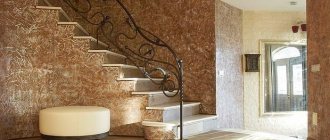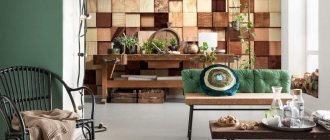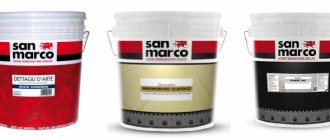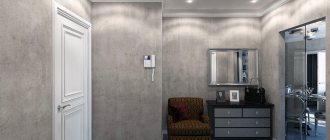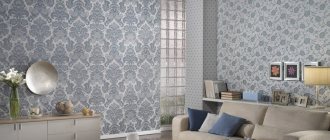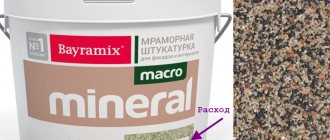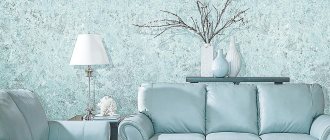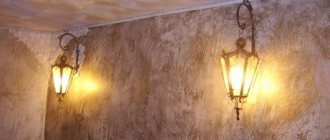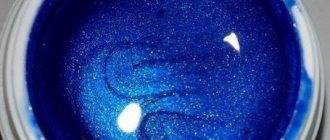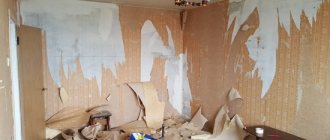Wallpaper for plaster - what is it, features
In fact, these are standard finishing strips, but they completely recreate the effect of plastered walls.
The peculiarity of the wallpaper is its texture. It is created by embossing or spraying polymers. Manufacturers produce several types of wallpaper for the types of textured plasters. Thanks to the relief design, the coatings create an atmosphere of luxury or minimalism, aristocracy or rustic comfort.
In fact, these are standard finishing strips, but they completely recreate the effect of plastered walls.
Advantages and disadvantages
The positive properties of wallpaper include decorativeness. On a paper, fiberglass or non-woven basis, textures are recreated that are beyond the capabilities of beginners. Dreams become reality.
You can create luxurious interiors yourself, without the involvement of specialists. There are wallpapers with the effect of aged walls, Venetian plaster with mother-of-pearl and gilding. Lovers of minimalism choose concrete finishes and decorative plaster with shallow relief.
The disadvantages of wallpaper include the fragility of vinyl and the poor moisture resistance of paper. The materials have no other significant disadvantages.
You can create luxurious interiors yourself, without the involvement of specialists.
Wallpaper or plaster, which is better, comparison
Although a categorical answer to the question of which is better is impossible, apartment owners more often choose wallpaper. For decorating cafes and other rooms where there are a lot of people, plaster is more practical.
What are the advantages of decorative canvases:
- Unlike natural finishes, wallpaper with a plaster effect is easier to apply.
- Repairs require less time.
- Wallpaper that imitates a convex plaster layer will not leave scratches, the material is soft and elastic.
- There are no visible joints on the texture stripes; they look uniform.
- The canvas, unlike plaster, does not fade under the influence of ultraviolet radiation.
Considering the ease of installation and low cost of wallpaper, plaster loses in all areas. Plastering is always more difficult than wallpapering.
Unlike natural finishes, wallpaper with a plaster effect is easier to apply.
Features and Specifications
Like any material, products vary in their composition and characteristics. The peculiarity of the product is that its appearance resembles decorative plaster. From a distance it is difficult to understand that these are ordinary trellises. But working with them is much easier and more convenient. And thanks to the wide range of products, everyone can choose the best option for their premises.
Imitation of textured plaster
The distinctive characteristics of the canvases are the relief pattern, which has visible irregularities and some roughness. The imitation is excellent, the similarity to the original plaster is high. Images are formed with various effects or imitate plaster stone or ordinary chaotic strokes on the surface.
The disadvantage of plaster wallpaper is that its presentable appearance may not last as long as we would like. This is especially true for areas that often come into contact with other objects or the hands of household members. It is not profitable to use trellises for a children's room or hallway.
Imitation of structural plaster
Such wallpaper under plaster draws attention to the structural part, the relief on the surface and some bulges. Typically, acrylic products are used for such options. They are suitable for these purposes, since the surface is dense and soft, so the structure being formed is clearly visible on it.
But, as in the first case, frequent contact with objects or mechanical influences spoil the material, it begins to wear out and wear out. Although, the advantage is that the color of the wallpaper under the plaster can be changed as needed, updating the design of the room.
Imitation of Venetian plaster
Venetian plaster is a type of decorative material that is applied in a thin layer and is similar to marble stone. If you use wallpaper that resembles Venetian plaster in the interior of a room, then for little money you can create an imitation of an expensive finish. The room will be transformed and acquire new colors.
The peculiarity of the coating is its various effects on the surface: original shine, the surface can shimmer under the influence of light, the resemblance of a marble wall (Italian marble), as well as elements of natural motifs. The advantage of the product is that it is wear-resistant, will not fade over time and has a huge range of colors and patterns.
Silk plaster (liquid wallpaper)
The peculiarity of the product is that it is sold in powder form, like putty. To apply it, it must be diluted with water in certain proportions. The advantage of such trellises is that they have an uneven surface and no joints are formed on the wall. The mixture is easy to apply, and if a part becomes damaged during use, it is easy to replace.
Advice! It is enough to wet the area well, remove the problem area with a spatula and apply a new mixture in its place.
This option is not suitable for wet rooms, since frequent exposure to water can leave marks on the wall. As for decorative qualities, liquid wallpaper does not have such a variety of colors, patterns and textures.
Under old plaster
The aging effect is in great demand, especially if the room is planned to be in a loft style. The peculiarity of wallpaper is that visible cracks, abrasions, and defects appear on its surface. Then the walls will seem old, but this antiquity is noble and beautiful.
How to properly apply decorative plaster with your own hands
There are several additional types of decorative plaster application:
- fur coat;
- "lamb";
- terrazite;
- foam.
All of them are done using special tools and hand movements. You can work with both granular and fibrous mixtures. Grinding machines, textured rollers, comb spatulas, and textured sponges are used.
The decorative effect of bark beetle plaster varies. It depends on the direction of the working movement of the plasterer’s hand. The application of vertical bark beetles is done with sharp movements in a vertical straight line. Horizontal - horizontally (a trajectory in waves is allowed). Chaotic - application in a circular motion.
The principle of sgraffito plaster consists of several steps. First, a layer of the color that makes up the design itself or the background surrounding the design is applied. Allow the layer to dry and settle. Then a second layer of a contrasting color is applied. Here you can no longer wait for complete drying. You need to have time to cut the necessary contours to get the drawing.
Working with the second layer of decorative plaster sgraffiti Source mvestnik.ru
You can make the right craquelure by applying acrylic paint of the same color to the wall surface. Let everything dry thoroughly. Then a special mass is distributed over the painted surface. There are options for compositions that crack on their own after drying. The remaining plasters are heated with an industrial hair dryer. Cracks will form in heating areas. This method is needed when you need to achieve cracks only in some places.
Clear lines of craquelure cracksSource remont-book.com
Anyone can treat indoor walls with mosaic plaster. If, for example, sgraffito requires the skills of a master, then the mosaic mixture can simply be applied using a regular spatula and a metal grater.
Applying decorative mosaic plaster with a metal floatSource kraski-net.ru
Before application, be sure to level the wall and then treat it with a primer. Sea Breeze should be applied correctly by spreading the topcoat over the wall. It is allowed to dry, and then decorative plaster is spread over the painted surface. It is better to repeat the pattern in increments of 1 square. At the end, let everything dry for 24 hours. Only after 2 weeks can the coating be washed with a damp cloth or sponge.
Perfectly applied sea breeze decorative plaster with the addition of silverSource art–deco.com
Wallpaper for plastering in the interior of your bedroom
Decorating a sleeping room also involves using materials of different colors. Thanks to the unobtrusiveness of the materials, the design solution of your bedroom will not contradict its purpose. But, still, try to make bright accents only in the area that is not noticeable when relaxing.
For example, in the bed area, a wide-format design will help add sophistication to the room. But, if you think that such a solution will look quite simple, think in advance about combining different materials, creating a variety of niches and projections, and also consider installing lamps and additional lighting.
Using wallpaper with mother-of-pearl, gilding or silver chips, you can add elegance to your bedroom. A room decorated in this way will always look gentle and cozy, and the absence of different designs and patterns on the walls will allow you to change the decoration of the room without re-pasting the wallpaper.
Furniture items for such a bedroom need to be chosen to match the tone. The only exception may be a dark room, for which it is better to choose lighter and contrasting furniture.
Wood also goes well with such wallpaper, especially light wood, which can be laid on the floor in the form of laminate or parquet.
Since plaster is more suitable for “urban” design and is rarely chosen for interior finishing work, you can brighten up such a room with the help of textile elements: choose matching curtains, carpet, bed linen, etc.
Color of personal choice and style
Accentuation is the most famous and most important design technique that always plays a win-win game. Especially then, the task is not only to refresh the room, but also to make it stylish, fashionable, and add a touch of sophistication and wealth. The choice of colors here comes second to the choice of material. Color is the mood, emotions and impressions that a person receives from the renovation.
The choice of color affects mood, emotions and impressions
It should be in harmony with the style, not irritate, not tire. The fundamental choice of color palette is based on four groups:
- Fresh. They give transparency, purity and spirituality.
- Warm. They calm loved ones, and add coziness to the room, making them ready to relax.
- Saturated. They have a high percentage of coloring matter.
- Calm. Soft colors, most often with shades of gray. This decision brings balance and peace to the home.
The color should be in harmony with the style, not irritate, not tire
Liquid wallpaper for walls (+150 Photos). How to apply, advantages and disadvantages of the material
Selection of brick-like wallpaper
When choosing brick-like wallpaper, you need to take into account the design of the pattern, texture and color of the canvas. These characteristics largely depend on the base and manufacturer of the finishing material.
PHOTO: blog.casualavenue.com High-quality wallpaper has a texture that makes the finish more realistic
Masonry pattern and brick texture
The pattern on the wallpaper can depict large, medium or small bricks that have a classic rectangular or almost square shape. Trellis can imitate old or new brickwork, which allows you to choose the finishing material in accordance with the style of the interior. So, for example, for a loft, wallpaper with an imitation of even and smooth masonry is suitable, and for Provence or country, the ideal solution would be uneven aged brick.
The higher quality the wallpaper, the closer the texture of the imitation is to the original. Some modern manufacturers of finishing materials add tiny brick chips to the canvas. This makes the coating more realistic not only visually, but also tactilely. You can enhance the relief of brick-like wallpaper using properly located sources of additional lighting.
Color scheme and color saturation
The color scheme of the brick-like wallpaper can be anything. The choice of color should correspond not only to the style of the room, but also to its size. The lighter the finish, the visually the room becomes more spacious. By combining light and dark shades of the same color, you can visually correct and disguise minor imperfections in the geometry of the apartment. There are three main colors: red or terracotta, white and gray.
Terracotta or red color is suitable for creating accent walls, covering entire rooms, arches, false columns, fireplace and TV areas. Decorating even one wall with such finishing will transform the room, change the interior style and mood.
White wallpaper is a great way to visually increase the space of a room, especially if the apartment is not large. The texture of natural brickwork gives volume and complexity to the space, and wallpaper with its imitation will save usable space. Bright decor and original textiles will help break up the monotony of the atmosphere.
Gray brick will be an excellent option for the background, especially if the interior focuses on large decor or furniture. Light gray brickwork will visually expand the room, while a dark shade, on the contrary, will hide the volume, but will help create a relaxing atmosphere in the room.
Varieties by composition
Wall finishing material fillers have different features, functional and technical properties. If this is an option for decorating surfaces with gypsum or lime, then you can safely count on their strength. Such mixtures are usually used to finish the ceiling between beams in interior styles: Provence, country, chalet, vintage, retro, loft. Or when plastering sections of walls to look antique.
Decorative plaster in eco-style living room interiorSource behance.net
Additional additives for decoration, creating an unusual coating:
- metallized threads;
- crushed shells;
- large cellulose fibers;
- pigments and colors.
Any decorative marble plaster in the living room, dining room, or hallway will not only beautifully recreate a beautiful pearlescent-shiny surface, but will also reliably protect the walls from various aggressive external factors. Neither mechanical damage, nor chemicals or detergents will damage the integrity of the coating. A number of other types of additives to plaster have the same or different properties.
Glossy marble plaster on the walls of the living roomSource odnastroyka.ru
Acrylic
Acrylic and latex decorative bases have ideal vapor permeability and durable operation. The strength is comparable to materials where gypsum is added to the composition. They are well suited for interior decoration of rooms such as kitchens or bathrooms. The texture is smooth, the walls are easy to clean from dirt.
External cladding of house facades is also done using plasters with such additives. The main advantage is that the walls “breathe” and are resistant to mechanical damage, rainy weather or weathering. Therefore, acrylic or latex varieties are suitable for finishing the exterior walls of houses in rainy or foggy regions.
Pleasant color and texture of acrylic decorative plasterSource ferrara-design.spb.ru
Mineral
A feature of mineral decorative plaster is its division into two main groups: marble and quartz. This can also include granite and composite mixtures. They are very similar to each other in terms of performance characteristics. The coating is moisture-resistant, and therefore can be used in bathrooms and kitchens where humidity is concentrated. Pros:
- perfect imitation of natural stone, marble;
- pleasant smoothness – semi-gloss pearlescent surface;
- wide range of colors;
- goes well with decor and furniture in classic, Italian, antique and English styles.
One of the main and only disadvantages of such decors is the surface structure. It is porous, so dust and small particles - pieces of threads, lint, wool, fibers - quickly stick to it. It is difficult to wash such walls, but it is possible with the help of special attachments for a washing vacuum cleaner. If the surface is finely porous and smoother, then it is less hassle to maintain.
Fine-pored decorative mineral plasterSource decorstudia.com.ua
Silicate
The main feature of silicate plastering mixtures is the form of the substance - liquid silicate glass. Once cured, it hardens firmly, creating a super-strong, wear-resistant surface.
Advantages of silicate plaster:
- excellent durability of the finished coating;
- property of repelling dirt and plaque;
- high level of moisture resistance;
- good heat resistance.
Such coatings are difficult to ignite from sparks or open fire. Therefore, they fully comply with all the requirements of building standards and fire safety regulations. Finishing is best used when decorating kitchens (kitchen splashback, entire work area), bathrooms, and even an indoor barbecue installed in the local area.
Elastic decorative silicate plaster paste. It is convenient to distribute it over the surface and form it into texturesSource stroimdom.com.ua
Silicone
The binding component is silicone, which is added to the ar-concrete plaster. The plastic substance is extracted from resinous elements. It lasts a long time as part of the applied mixture. The mass can be used for finishing both external and internal walls. Plaster with excellent moisture-resistant properties, so it is suitable for furnishing kitchens and bathrooms. Additives can be different pigments. But there are always stabilizers, fillers, and antifungal concentrate.
The homogeneous texture of silicone plaster allows you to decorate the surface of the applied layer using a textured rollerSource kraski-net.ru
Plastering a wall under wallpaper
Plaster is used to prepare the wall surface before wallpapering. It is necessary for leveling the walls. Smooth walls promote better adhesion of wallpaper and increase their wear resistance. You can make the plaster yourself, but it is better to purchase a ready-made composition right away.
Mixing the solution with your own hands is not difficult, and it is also cheaper. But ready-made formulations are much more convenient to use, because they are already mixed in the right proportions. They are also distinguished by their main composition, which is necessarily indicated on the packaging.
The components of plaster are divided into 2 types:
- Cement mortar;
- Plaster.
Experts recommend plastering walls under wallpaper with gypsum mortar. Cement is mainly used for external use. Plaster also differs in quality and application.
Before wallpapering the walls, be sure to plaster and prime all the walls.
The compositions are divided into several groups:
- Simple medium quality, requires several layers;
- Improved, has more advantages, requires application using a special technology, which is carried out in several stages;
- High-quality - dry or ready-made mixture, which is used for decorative purposes, can have different colors and textures.
Before wallpapering, it is best to use the second group.
Advantages of decorative plaster
Excellent combination of gray and white in the interior
Decorative plaster has advantages over other finishing materials
Decorative effect of concrete
- quite easy to apply to the surface;
- no additional finishing work is required before application, but it is mandatory to apply a primer and prepare the wall;
- compared to others, a fairly inexpensive finishing material;
- easily masks imperfections in the wall, eliminating the need for repairs;
- prevents mold;
- plaster is resistant to moisture and temperature changes;
- imitates stone, wood, marble, granite, silk quite well;
- you can make patterns and drawings on the wall and ceiling;
- is an environmentally friendly product.
Plaster option in the living room
Advantages of decorative plaster
Advantages and disadvantages of wallpaper for plaster
Wallpaper for decorative plaster has a number of advantages, however, like other materials, it has its drawbacks. Let's look at them in order.
Pros:
- Impeccable appearance. It is possible to create the illusion of a noble material.
- The product holds its texture perfectly and sticks perfectly to the surface. And non-woven wallpaper tends to let air through.
- The ruler for Venetian plaster has a fiberglass canvas. It gives the material durability and increased strength.
- Products that imitate aged plaster are made from non-woven or fiberglass. Therefore, it is easy for beginners to work with the material; it has an affordable price.
- Liquid wallpaper is very practical, there are no joints left, they are easy to apply and also easy to remove. If they are damaged, just wet them, remove them and apply a new layer.
- Each of the options is easy and quick to apply to the surface, be it roll or liquid material. Pasting can be completed within 24 hours.
- The price for roll materials that imitate natural plaster finishes is much lower than for the original, so everyone can afford such an exquisite finish.
- There are no wet processes, cleaning after work is much easier and faster.
- The coatings can be washed using detergents.
As for the disadvantages, we note the fragility of paper versions and instability to mechanical damage. And not the entire line can withstand the influence of moisture, temperature fluctuations and the influence of UV rays.
Based on this, everyone can decide for themselves what is better, using wallpaper under decorative plaster or the plaster itself. After all, each of these options has its own characteristics and advantages. But, for example, not everyone can afford decorative plaster. But trellises are a simple and effective option. In addition, it is important to take into account vapor permeability, resistance to external influences, ease of use, and ease of operation.
Disadvantages of wallpapering
The disadvantages include the following:
- during the next renovation, it will be very difficult to remove wallpaper from the wall, since it has very strong adhesion to the wall thanks to the glue;
- they are difficult to clean from dirt. When interacting with water, the wallpaper may deteriorate. Recently, it is not uncommon to see special washable wallpaper, but it is also very difficult to clean;
- The coating is easily torn off by pets. Although this will not harm your pet, the wall will lose its presentation and the effect of the repair will quickly disappear;
- They cannot be glued in rooms with high humidity. Wallpaper will quickly deteriorate and peel off from the wall;
- Even with perfect repairs, this material will have to be replaced after 5-7 years. Wallpaper is not designed for long-term use, and those that can withstand it cost a lot of money;
- Even with slight interaction with a sharp object, the coating will tear.
Curtains made of snowflakes: how to decorate a window for the New Year
Paper snowflakes can look beautiful on windows as holiday curtains. String paper snowflakes onto a thin thread with beads and other items you want to hang on the line. Hang a few of these snowflakes on the cornice and you're done. Instant holiday curtains. Inside, the windows immediately look New Year's, and passers-by will enjoy your festive splendor from the outside. In general, paper snowflakes are the easiest way to decorate your apartment for the New Year. They can easily be made from white computer paper - a suitable budget option for holiday decor. This article shows how to make paper snowflakes for window curtains. This folding technique works for any snowflake. When you cut a folded triangle, you get different shapes and designs. To make different sizes, use different sized paper or cut the folded triangle to size before cutting out the design. Link to instructions below.
Craft snowflakes for home decoration
If you're looking for an easy project for kids so they can get involved in decorating their home for the new year, check out this fun idea. This popsicle stick craft is the perfect solution to two problems: it will keep the kids busy for at least an hour and you'll have a cute and quirky craft to decorate your living room with!
The instructions can be read on the website.
Varieties
Wallpaper as decorative plaster is available in the following types:
- vinyl;
- duplex;
- non-woven;
- acrylic;
- liquid texture.
Duplex
Paper types with embossing are called duplex. The material is double, produced by wet stamping technology. Wallpaper can be white for painting or with color images. The first ones have a textured surface and can withstand several tonings.
The advantages of duplex wallpaper are as follows:
- increased strength compared to single-layer paper materials;
- environmental friendliness of the composition;
- affordable price;
- high breathability.
The list of disadvantages includes a short service life and instability to mechanical damage. In addition, the coatings are not suitable for wet cleaning.
Vinyl wallpapers
The top layer of vinyl wallpaper is decorative, made of polyvinyl chloride. The base of the wallpaper sheets is made of paper or non-woven fabric. When performing the hot stamping technique, the wallpaper base with foamed polyvinyl chloride is heated and passed through a roller with a relief surface.
Wallpaper of this type comes in several varieties:
- Flat vinyl - the material is characterized by increased density, wear resistance, strength, and moisture resistance. The textures of natural stones, ceramic tiles, and brickwork are reproduced on the surfaces. This material is used for kitchen finishing; surfaces can be cleaned with detergents or a damp cloth or brush.
- Heavy vinyl - these versatile canvases can be used to decorate different types of rooms. The material is moisture-resistant, durable, aesthetic. Thick coating can be fixed on walls without puttying or priming.
- Silk-screen wallpaper is made using the technology of embossing paper soaked in liquid vinyl under pressure. The material is thin with iridescent shades and silky texture. The wallpaper is premium class and is used to decorate interiors in baroque and classic styles. The walls must be carefully leveled before gluing the sheets.
- Wallpaper made using the hot stamping method is durable (shelf life 7-15 years), resistant to ultraviolet rays, high air humidity, and hot steam. The materials do not absorb odors and can be cleaned with a damp cloth or detergents containing abrasive particles. It is necessary to take into account the low breathability of the fabrics. Before gluing the sheets, you will need to treat the walls with an antifungal primer.
Acrylic wallpaper
They have a base made of paper or non-woven fabric, the top layer is coated with acrylic. During production, acrylic is applied to the canvases in spots for patterns, so the breathability of the material is completely preserved. After heat treatment, the applied composition forms a relief pattern. Acrylic canvases are less durable than vinyl ones, because... spraying in the form of a pattern is not resistant to mechanical damage and high humidity,
Non-woven wallpaper
They are multilayer, made of non-woven interlining and cellulose fibers. The top layer of the canvases has a relief image. Manufacturers often produce white material for painting, but there are also color options. Surfaces can be repainted up to 10 times while maintaining the relief top layer. The material is environmentally friendly, safe to use, and has good breathability. If necessary, the canvas can be removed and hung in other areas of the house.
https://youtube.com/watch?v=y5SEJbA4KXg
Photo ideas in the interior of rooms
In the living room
The living room as a room has several functions: it is a hall for receiving guests, a relaxation room and a place of most frequent stay. The living room should be comfortable and cozy; at the same time, you can use bold colors and patterns, different combinations of textures and materials in the hall. For example, rich colors can be in harmony with three-dimensional patterns on other surfaces.
In the kitchen
For the kitchen it is worth using practical coverings. Wallpaper to be painted must be permeable to air to avoid the appearance of fungus, in contact with water for easy care, and not absorb odors. Fiberglass and vinyl coverings are well suited for this.
The photo shows washable lilac wallpaper in the kitchen interior.
In bathroom
The most important indicator for a bathroom is increased resistance to moisture. Paint can enhance this property. Paintable wallpaper is an unusual way to decorate a bathroom; it looks elegant and goes well with tiles.
In the bedroom
The bedroom is a place for sleep and relaxation; it should be as comfortable and cozy as possible. The color will contribute to a pleasant atmosphere. Using wallpaper for painting, you can simply change the atmosphere, refreshing the interior.
In the nursery
The little creatures are known for their love of “wall art.” Paintable wallpaper is a solution for quick repairs; the paint can also be water-repellent, which will greatly simplify surface care. It is worth remembering that the priority is to use natural, high-quality and environmentally friendly materials.
On the balcony
For loggias and balconies you will need a coating that is resistant to changes in temperature and humidity. The ideal option for finishing would be paintable fiberglass wallpaper; they are not afraid of weather changes and mechanical damage.
In the corridor
The decoration in the corridor can be combined with other coatings. For example, a wall that is most susceptible to mechanical damage can be decorated with artificial stone or brick, and a small room will be made more spacious by a tall mirror of an unusual shape.
What is “Venetian” wallpaper?
General information
Venetian plaster is also called liquid marble, since its composition includes marble flour, sometimes malachite or granite, in addition, the composition contains slaked lime and resins. The coating is applied in several layers, resulting in a special texture and beautiful color shifts.
It should be noted that the high price of such finishing is associated not only with the use of expensive components in the plaster, but also with the complexity of its application. Therefore, even if you buy the mixture, you are unlikely to be able to apply it correctly yourself.
Venetian plaster
However, this is not a reason to refuse such wall decoration. An excellent alternative to natural “Venetian” is wallpaper that imitates this coating. They are made of vinyl applied to non-woven or paper fabric.
It must be said that the vinyl layer is quite thick, thanks to which it reliably imitates the multi-layer structure of Venetian plaster with its iridescence of colors and unusual texture.
Advantages
Of course, in addition to their attractive appearance, such wallpapers also have other advantages:
- the cost is much cheaper than natural plaster - from 1500 to 5000 per roll, depending on the manufacturer;
- You can glue the canvases yourself;
- the coating is moisture resistant - non-woven fabrics can be washed with a damp sponge and detergents;
- The vinyl top layer is UV resistant so it won't fade;
- have dust-repellent properties;
- are quite wear-resistant and durable;
- a large selection of colors, which allows you to choose canvases for any interior.
An example of using “Venetian” wallpaper in different colors
As for the disadvantages, these include the high cost compared to other types of wallpaper. However, given the durability of this coating, good performance and impressive appearance, this price is completely justified.
Wallpaper Grandeco
Peculiarities
Wallpaper for plaster is nothing more than ordinary rolls of canvas. They can be non-woven or paper based. Like many other models, they are made of vinyl, which greatly simplifies their gluing. The nature and complexity of gluing Venetian wallpaper will depend on the composition of the material.
The peculiarity of wallpapering on paper is that the glue is applied both to the material and to the wall. The non-woven surface of the material allows you to apply the adhesive base only to wallpaper.
The peculiarity of these wallpapers is also that they are much heavier than usual. And the thicker they are, the more realistic the imitation effect will be recreated.
Is it possible to glue wallpaper onto plaster?
If a person decides to change the interior and wonders whether it is possible to glue the material onto cement plaster, then the answer will be negative; doing this is strictly prohibited.
There are several reasons why it is prohibited to glue wallpaper onto cement or clay plaster:
- The plaster will absorb moisture from the glue and the sheets will quickly peel off;
- If the wallpaper is light, then the walls will be visible;
- Over time, cracks or breaks will appear on the old plaster under the wallpaper;
- Paper wallpaper glued to clay plaster may become covered with red spots over time.
If you still want to hang wallpaper yourself, then you need to first prepare the surface: plaster it with a finish, prime it.
Advantages
The positive qualities of Venetian wallpaper include:
- Strength. Due to their thickness, these canvases are less susceptible to damage during operation and during gluing.
- Moisture resistance. Non-woven fabrics can be washed with all kinds of household products, excluding those that contain aggressive chemicals (chlorine).
- Resistance to light. Wallpaper does not fade under prolonged exposure to sunlight.
- Durability. Thanks to their high strength, resistance to moisture, light and dust, such wallpapers explain their durability.
- Resistant to dust. When making wallpaper, a special composition is applied to it that repels dust.
- Easy to stick. You can glue the material very quickly. It will take much longer to apply several layers of plaster. In addition, the canvases have smooth edges, which facilitates their smooth joining and pattern compatibility.
- Low cost. Compared to real Venetian plaster, the price of wallpaper will be affordable for almost any buyer.
- Big choice. Taking into account the style of the interior, you can choose wallpaper with any texture and decorative elements.
When gluing “Venetian” in one room, it is important that the batch numbers of the rolls are the same. Otherwise, the difference in shades of the canvases will be noticeable after gluing them
Styles
Designers use coatings with a plaster pattern to create any style - from classic to high-tech. Thus, embossed wallpaper with the effect of an aged surface fits harmoniously into both classic and ethnic styles.
Natural motifs (waves, clouds, plants) are found in almost all directions. But the mysterious shine of the metal is ideal for high-tech interiors.
Imitations of a concrete wall look unusual. This coating does not have a clear relief, but has a rough surface and a characteristic texture. The concrete effect is most typical for the industrial loft style.
Marble wallpaper imitating Venetian plaster will appeal to lovers of Italy. Venetian plaster combines naturalness and carelessness - qualities that distinguish Italian traditions in interior design. However, marble-like finishes are not limited to Italian style; they can become the basis of any interior.
Where is wallpaper with a plaster effect used?
Wallpaper for plaster is used in rooms of various purposes and styles. In the living room, neutral tones are optimal; inserts with an aged surface and golden plating can be used to create accent areas.
For the bedroom choose textured wallpaper in light pastel shades. One wall can be decorated in a contrasting accent color. A monochromatic design can be emphasized with moldings. Wallpaper with Venetian plaster looks impressive.
To decorate the kitchen, fabrics with water-resistant characteristics are used; materials are selected that are resistant to wet cleaning. Wallpaper in country style is combined with wooden furniture and metal. Coverings of this type can be used to decorate the dining area. The kitchen apron and areas next to the cabinets are decorated with sheets of brick shades or stone.
High-strength fabrics are used in the corridor. Rolls with a paper base are not recommended. Vinyl wallpaper is optimal as it is the most wear-resistant and can be combined when decorating corridors with natural or artificial stone or brickwork. The technique will ensure protection of sections of the wall.
In the living room, classic design canvases are optimal. Wallpaper materials for plastering are used to cover all walls or create accent areas.
Wallpaper with an aged effect looks good in the living room. Textured monochromatic canvases will complement rooms in the style of hi-tech, loft or minimalism.
Tips for beginners
If you decide to plaster the walls yourself with textured mixtures, I suggest you listen to the advice of professionals:
If you do not have experience working with this material, choose simple types of plaster; you can apply relief designs using stencil rollers. They can be bought at any construction market.
Unusual living room design in purple
- In plaster bark beetles, use special granules in your work. Move them in the desired direction with spatulas.
- To create bas-reliefs, stucco moldings, and three-dimensional decorative figures, use gypsum compositions, provided that you can do this. Otherwise, you can buy ready-made ones. There are plenty of them in hardware stores too.
- If up to this point you have no experience and have never worked with decorative plaster, try your strengths and capabilities on an inconspicuous section of the wall of a balcony, loggia or toilet.
In dark, neutral colors
Consider the features of your walls. Textured plaster fits well and without problems on surfaces made of brick or concrete without prior preparation.
Consider the climate conditions of the room. For example, you can buy any type of covering for the living room, corridor or bedroom
And in the bathroom or kitchen, where the climatic conditions are unstable, pay attention to silicate mixtures. By the way, they can be periodically updated and repainted. When choosing colors in the bedroom, consider the location
If it is located in the north, use coffee shades, beige, orange, burgundy or pink. If it is sunny, then it is preferable to use cold colors: green, gray, blue.
Cozy corner for relaxation
Modern landscape design of the courtyard of a private house (160+ Photos). How to beautifully arrange and decorate with your own hands
Tips for choosing
When purchasing materials, the following nuances are taken into account:
- Relief coatings are used for areas with little external contact (living rooms); textured materials are not used for corridors.
- The shelf life of the materials is taken into account; depending on the composition, wallpaper can last 30-50 years.
- The color scheme and texture pattern of the coatings can visually change the area of the room. Dark canvases and large ornaments visually make the room smaller, while the use of light colors and small patterns allows you to visually expand the space.
- Wallpaper with imitation plaster is combined with similar finishing materials, as well as brickwork and stone surfaces.
- When selecting the texture of wallpaper, style features are taken into account. Venetian plaster is not suitable for rooms in the Scandinavian style; wallpaper in the form of imitation concrete is not used in classic interior solutions.
- In large living rooms, inserts of rich tones are recommended for zoning the room. You can visually narrow a room using materials with large patterns.
- For the kitchen, roll sheets with moisture-resistant characteristics, resistance to changes in temperature conditions, dense texture, and wear-resistant are selected.
Interior design ideas in various colors
Beige
A shade for a calm interior design, it will look good both in a spacious living room and in a compact nursery.
The brightest, and at the same time easily soiled color. It will make the room seem as bright and spacious as possible.
Blue
A pleasant blue tint will not only encourage a pleasant pastime, but will also visually make the room more spacious. Blue has a refreshing effect on space, so the best place for it would be a sunny room.
Green
A juicy shade can have a relaxing or, on the contrary, a tonic effect. The color is certainly associated with summer greenery or a juicy apple. It has many shades from mint to emerald.
Peach
A gentle, cozy shade combines orange and pink tones. The most successful combination will be with white, turquoise and mint colors.
Pink
The romantic and playful shade consists of a fusion of red and white tones. Pink color can be combined with white, gray, lilac shades.
Grey
The stylish color has cold and warm shades. It is absolutely neutral and combines well with other colors.
Pearl
A light pearlescent sheen adds luxury to the interior of the room. Will be associated with a seashell or natural stone.
Gold
Gold symbolizes wealth and luxury. Too much use of gold paint can overload the interior; the best option would be a light touch of gold in the main color or decorative details.
Light green
A bright and rich shade of green. The color is very energetic and strong. When decorating a room, it is better to combine it with a calmer palette.
Black
The best place to use it is an open room with plenty of daylight, in which case the black color will not “eat up” the space, but will make it stylish.
Photos of wall decoration in the interior of rooms
Living room
The hall can be decorated with either one type of wallpaper or different materials. In a small room, both options are suitable. In the interior of the living room, you can combine different patterns and colors, highlighting some areas with the help of photo wallpaper or zoning the space.
Bathroom
For bathroom walls, it is imperative to use a material that is resistant to high humidity, such as fiberglass or vinyl. For greater reliability, it is better to combine the finishing with painting or wall panels.
Kitchen
The color of the walls should be combined with the kitchen set; these can be harmonizing shades or a similar color in the elements. It is recommended to use washable wallpaper for the kitchen. The dining area can be decorated with wallpaper with a large pattern, kitchen photo wallpaper, or, conversely, with a nondescript ornament.
Bedroom
The decoration of the bedroom can be done in different ways: with photo wallpaper, completely in one color, highlighting the sleeping area, finishing the wall above the head of the bed with a different color, or combining different coverings in a horizontal way.
Children's
In a child’s room, a good idea would be photo wallpapers, options with playful pictures or just different colors. Shades should be used that are not too bright, but positive.
Hallway and corridor
For the walls of a closed hallway or with poor lighting, it is worth using a light color of wallpaper; they can be combined with artificial stone or brick. In open rooms, you can focus on color, highlighting, for example, one of the walls.
Toilet
Toilet walls require coatings that are highly resistant to moisture and mechanical damage. The best solution for decorating a standard or small room would be a light palette or photo wallpaper that increases the space.
Balcony and loggia
Considering possible frequent temperature changes, it is better to use materials that are heat- and moisture-resistant for the walls of the balcony, as well as those that do not fade in the sun. Wallpaper for a balcony made of cork, bamboo, or photo wallpaper will look interesting.
Other rooms
Cabinet
The work room should be decorated with wallpaper, the color of which will stimulate activity, for example blue or gray. The design should not be distracting or provocative; a simple ornament will be enough.
The photo shows checkered wallpaper in a classic office interior.
Wardrobe
For dressing room walls, you should choose a finishing material that is resistant to mechanical damage. The color can be anything from a playful print to a simple plain neutral shade.
The photo shows brown wallpaper with a gold pattern in the dressing room.
Billiard room
For the walls of the billiard room you will need wallpaper with sound insulation and increased strength, for example cork or fabric. The color should be muted and dark so that it does not interfere with the game.
The photo shows striped fabric wallpaper in the billiard room interior.
Attic
A room on the attic floor is a separate cozy corner in the house. The walls can be decorated with wallpaper with a small floral or floral pattern, wood imitation or a calm plain canvas.
In the photo, the walls in the attic are decorated with photo wallpaper.
In a private house
Ladder
The walls of the staircase are decorated depending on the style of the house. The decoration can be in the same color scheme as the rest of the room or become a bright accent due to color or a large pattern.
Dining room
Wallpaper for the walls in the dining room should be conducive to a pleasant pastime. The pattern and color are determined by the style of the dining room, but it is better to stick to light shades and unpretentious prints.
Hall
It is better to choose a calm drawing, without bright elements, although in some styles, for example pop art, this would be quite appropriate.

